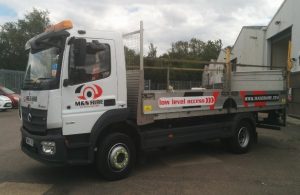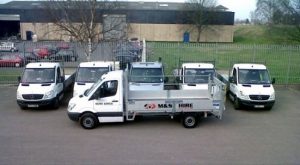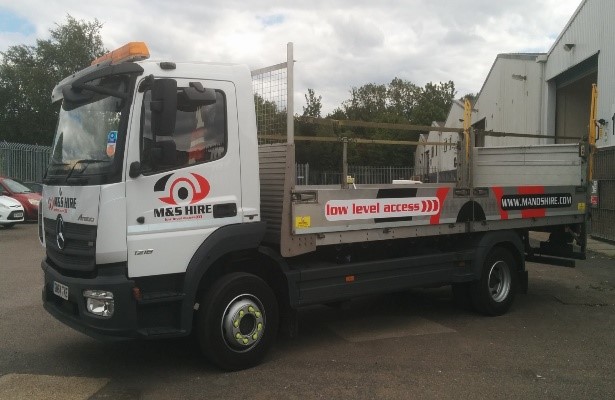 Section 1 – Introduction
Section 1 – Introduction
M&S Hire is based in Sittingbourne and supplies low level access equipment and associated items to the construction industry in London and the South East. It is located near the M2 and M20 motorways both of which are linked to the London Orbital M25.
Julian Bush, General Manager, explains how M&S Hire has achieved significant improvements through FORS (including reductions in fuel use / reduced CO2 emissions, lowered NOx and Particulate Matter emissions, improved its road safety record, decreased transport related fines and charges etc.)
Section 2 – How did you hear about FORS, what prompted the company to join and how long have you been a member?
We first heard of FORS from one of our customers in July 2013. We realised it would help us to achieve best practice and benefit us by actively demonstrating our commitment to all safety related matters and enable us to manage our mileage and fuel usage more effectively. It would also allow us to gain more business, thorough a higher profile, contractual requirements, and more efficient operations.
Section 3 – What was your experience of the initial FORS Bronze audit?
M&S Hire passed the Bronze audit at the first attempt. The Audit made M&S Hire focus more on monitoring and controls of MPG, Emissions, PCN’s etc. By monitoring the carefully using the Transport management tool we can effectively reduce all of the above. Better trained staff improved operations and increased efficiency. The auditor was happy to answer questions and assisted us in improving the company.
Section 4 – What was your main reason for you progressing to Gold?
We decided to progress to Gold because we felt having the highest award for our fleet management would reflect Once we were Bronze, we decided that we should progress to Silver because of the operational improvements seen from implementing the changes needed for Bronze accreditation, in particular the cost savings and environmental benefits. Now being confident from having both Bronze and Silver Accreditation we decided to add HGVs to our fleet and the following year achieved Silver with both Vans and Lorries. This success and operational improvements encouraged us to go for Gold at the end of 2016.
Section 5 – Explain how you have made use of the benefits FORS provides?
We made the most of the benefits on offer, the Fleet check system we use to manage our entire fleet including fuel, daily vehicle checks and PMIs. We have also made extensive coverage or the FORS training courses with the General Manager becoming a FORS practitioner and well as all office staff working through the online training courses. All of our drivers have attended the FORS safe Urban and have taken advantage of the excellent eLearning Modules to further their skills. The use of these FORS tools and training has led to lower costs, greater efficiency and greater customer satisfaction through enhanced performance, this is turn has led to growth in the business.
‘Introduction of the FORS standard has improved operations and demonstrated to our customers that we are a professional operation and that has enabled us to win more work.’ Julian Bush – General Manager
A more robust operation has allowed us to expand with minimal disruption’ Gary Armstrong – Account Manager
Section 6 – What improvements have you made?
- Performance data – Whilst we have progressed from just vans to HGVs this has not had a significant impact on our efficiency. If you look at the detailed fuel usage the vans are just as efficient as always. Inline with the new FORS requirements we now monitor CO2 and particulates, therefore we at present have no historical data to compare with. The empty roads caused by the national lockdown has improved our fleet performance massively in the last 12 months.
|
|
MPG |
Incidents per 100,000 Kms | CO2 | NOx | PM10 | Number of PCNs |
Proportion of fleet that uses alternative fuels |
| 2019-2020 | 17.36 | 1 | 45.52 | 126.2 | 1.88 | 31 | 0% |
| Van 2020-2021 | 29.65 | 0 | 65.90 | 246.82 | 4.16 | 10 | 0% |
| HGV 2020-2021 | 26.6 | 1 | 32.75 | 273.82 | 4.09 | 11 | 0% |
 Driver health and fitness review – Through the FORS improvements we now have two checks on our drivers, initially at the start of the Shift the drivers are met by the lead driver who ensures that the drivers are fit to drive. Additionally, their manager meets them at the end of the shift and as part of the driver daily debrief the manager assess them and asks how they are. We also perform an annual medical self-assessment on the drivers. And of course, our HGV drivers have to have a doctor’s medical as part of their licence requirements
Driver health and fitness review – Through the FORS improvements we now have two checks on our drivers, initially at the start of the Shift the drivers are met by the lead driver who ensures that the drivers are fit to drive. Additionally, their manager meets them at the end of the shift and as part of the driver daily debrief the manager assess them and asks how they are. We also perform an annual medical self-assessment on the drivers. And of course, our HGV drivers have to have a doctor’s medical as part of their licence requirements- Recruitment of drivers – We only have 6 drivers and have only recruited one driver in the last couple of years. Because we upskill our drivers ourselves and pay for the driver to convert from van drivers to HGV drivers it helps us with loyalty and retention of our drivers. It is our policy to recruit van drivers and to develop them into HGV drivers ourselves.
- Noise assessment – As part of the FORS Standard we have performed noise assessment and measurements of the noise made during our fleet operations. These measurements have led us to make a couple of changes. Now all of our vehicles use only white noise reversing beacons and as part of our operations we do not deliver or collect between the hours of 07:00 and 22:00 in residential areas.
- Modal shift and alternative vehicles – there are currently no vehicles capable of delivering to ad-hoc unforeseen addresses across the southeast that have the range and carrying capacity to deliver lifting platforms to our customers construction sites. Once the vehicles are available then we will lobe to alternate fuelled vehicles.
Section 7 – What are your plans for the future?
We have already transitioned the vehicle fleet to the latest Euro IV engines which is the latest standard and cheapest for the ULEZ in London, where we primarily operate. And due to research, we have realised that it is less harmful to the environment to install air conditioning, better mpg than driving with the windows open. We are hoping that the changes to diesel vehicles announced for 2040 and now 2030 means that hybrid vehicles will soon appear for commercial use. We will also be paying close attention to any information coming out of FORS either through the regular correspondence we get from FORS or from the conference which hopefully reappear once this pandemic has been dealt with.
Section 8 – What evidence do you have of positively promoting FORS at requirement G7?
All of our fleet have the FORS ID badge at the back of the truck and also on the driver door, allowing all who speak to our drivers in particularly site contact, site managers to see the FORS logo. Our website contains our Case study and the FORS logo is prominently displayed on the website.
Our company headed paper also has the FORS logo and therefore appears on every invoice to all our customers we send out as well as all orders to suppliers. It is also on the bottom of every email so all company correspondence contains the Logo.
Section 9 –What FORS Gold accreditation means for your organisation/to you?
Conclude
Since joining the FORS scheme in July 2013 the company has dramatically improved its management of its fleet. This improvement has entailed better route planning, fuel and cost savings, lessened the impact on the environment and increased record keeping which improved future planning. These improvements allowed us to introduce HGV to the business and succeed. With the staff and drivers better trained and more competent we intend to during the economic recovery to increase our fleet with possibly more HGVs. Also, the transition to alternate fuels should be straight forward now that training and communication lines between management and staff are open well used and transparent.
Section 10 – (Optional) Please provide your social media contact details so we can follow your organisation

